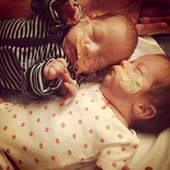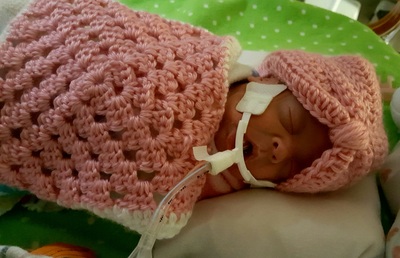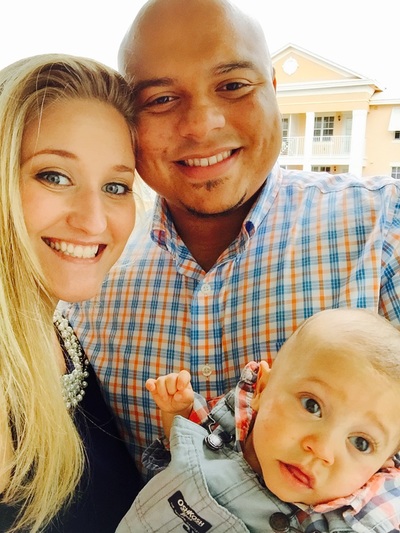|
Necrotizing Enterocolitis is common among ill or premature infants that occurs when bacteria invades the intestine. This bacteria causes an infection and inflammation which ultimately destroys the bowel or intestine. “NEC affects one in 2,000 to 4,000 births” which ends up being “between 1 and 5% of neonatal intensive care unit admissions” [1].  Lucelena and Cecilia Rebecca Casillas’s twin girls, Lucelena and Cecilia, were born at 28 weeks and 5 days. Lucy at 2lbs 8ozs and Ceci at 2lbs 2ozs. The girls had varying degrees of respiratory therapy and were making good progress on temperature stabilization, weight gain and oxygen levels. About 6 weeks into their NICU stay, both girls started losing ground and backtracking on many of the gains they had made. They moved back into incubators from an open bed, off of room air back to O2 all within 2-3 days of each other. They both were diagnosed with medical necrotizing enterocolitis (NEC) and began a 7-10 day treatment of antibiotics. It was so hard for Rebecca and her family to see the girls go back to the IV fluids (total parenteral nutrition) after they were getting the hang of bottle and breast feeding. It was equally hard for them to know the taste of milk and feeling of a full belly and then everything be taken away. There were many scares with x-rays of their bowels that got worse before they got better and once they were cleared for feedings again, we had to start slowly and build everything back up from what seemed like Day 1. But as most things go in the NICU, we took it one day at a time and miraculously, on their original due date, the girls were able to come home with very few issues. They are now both thriving at 16mo olds and enjoying each day as they learn and grow, progressively acting more and more like their actual age vs the age adjusted for their prematurity. The Casillas family is so thankful to the medical team at Magee Women's Hospital that caught this issue before it became surgical. It is truly amazing how strong the fight is in these children and how inspiring they can be. Rebecca hopes that their story gives those going through a similar situation comfort. They are sending good vibes out to all those still fighting.  Easton and Isabella Easton and Isabella were born on April 2, 2016 at 23 weeks 1 day. They each weighed 1lb 7oz and 11 inches in length. Isabella was Rachael Erickson’s lung girl, she had a patent ductus arteriosus (pda) that closed, a chest tube inserted within the first 2 weeks, pneumonia and a run in with NEC. It took 3 rounds of steroids at different times to get Isabella on low flow O2. They thought she would end up with a tracheotomy but fortunately her symptoms did not worsen. They eventually found that she was aspirating with her feedings. After this discovery was made the hospital team got her bottling on thickened feedings and she did great. Easton had a grade 1 Bleed which resolved on its own, PDA which resolved on its own, Avastin injections for ROP, Ecoli from the breathing tube, and got NEC twice. Easton got NEC within the first 10 days but did not develop any perforations. He was started on feedings again however the NEC developed again. He had surgery at 2 months old and received 2 stomas. After surgery he was considered “failure to thrive” as he wasn't gaining weight and was not absorbing his feedings. His intestine protruded greatly which caused him to have another surgery 7 weeks later to reconnect. Surgery was a success and very little intestine had to be removed. Easton is now on feedings but is struggling with his breathing. The hospital staff didn't think Easton would make it after his second run in with NEC. Now all they say is he is a miracle. Isabella came home at 9lbs at 137 days old, she is on low flow O2 but doing great. [1] http://www.chla.org/necrotizing-enterocolitis
 When Kelly Guzman discovered she was pregnant she was overjoyed, and since it was her first, she was blissfully unaware that anything could go wrong. According to her, it was a difficult pregnancy; she lost weight and barely had an appetite. But she continued to visit her physician who assured her everything was going smoothly. At her 20 week exam she discovered they were expecting a boy, who her and her partner named Joshua. The doctors also thought they noticed some abnormalities, and became insistent that the baby had a genetic deformity. If she didn’t miscarry, the doctors strongly recommended aborting the baby. To this, Kelly firmly resisted. At 27 weeks, Kelly started experiencing sharp pains and debilitating nausea. As it turns out, she was suffering through the early symptoms of HELLP syndrome, and could have bled out or potentially lost the baby at any moment. A week later she underwent an emergency C- section which required 3 blood transfusions to bring her platelet count up to a survival level. Joshua was still-born, but miraculously revived, weighing just 1 pound, 11 ounces and severely jaundiced from oxygen deprivation. Joshua was so small because he was restricted to growing only on the left side of Kelly’s uterus, as she also had an undiagnosed uterine abnormality, a bicornuate uterus. Because this was her first baby, there was no way she could have ever known she had this irregularity. After being in the St. Mary’s NICU in West Palm Beach, FL for 7 seven days, Joshua was transferred to Nicklaus Children’s Hospital in Miami, as he had suffered a grade 3 brain bleed with enlarged ventricles. Joshua’s limited oxygen also lead to an excessive amount of folding on the brain, called polymicrogyria, which can cause seizures. For the ensuing 140 days, Kelly and her partner drove the 2-3 hour drive every weekend to watch over Joshua and comfort him as best they could. Finally, at 8 weeks old and on her birthday, Kelly was able to hold her son. They weren’t clear of all troubles yet, as Joshua still needed surgery to close a flap near his heart which had not fully healed. He had also developed chronic lung disease and bronchopulmonary dysplasia, because he was required to be on ventilator support throughout his stay in the NICU. Not being able to see Joshua daily, coupled with the fact he was kept sedated, were the hardest parts for the parents. In order to keep him calm and to help accept the life support, Joshua was on a constant drip of either morphine or fentanyl for his entire stay. The withdrawal effects of these drugs were especially painful, and the reason he needed to stay so long in the Nicklaus NICU. After 147 days in two NICUs, Joshua was finally released, weighing just over 6 pounds. Kelly is happy to report that a year after his discharge, Joshua is doing perfectly fine, with no genetic abnormalities or residual complications. He is crawling, taking his first steps and saying his first words. After going through a pregnancy complicated by HELLP syndrome and an extensive stay in a NICU, Kelly hopes that her story can be an example of not only what can go drastically wrong, but what can go unexpectedly right. Pregnancy Complications – Preeclampsia and HELLP Syndrome A variety of complications can arise unexpectedly during pregnancy, causing many women to have a very difficult experience. This sometimes can be due to the personal health factors of mother, which when left unnoticed, lead to problems as the pregnancy progresses. The severity and type of challenges can truly run the gauntlet for women, from the onset of gestational diabetes, to premature labor and miscarriage, to severe and persistent nausea and vomiting (hyperemesis gravidarum).[i] One of the most critical and life-threatening problems that can occur is preeclampsia, and its severe variant HELLP syndrome, which are characterized by the sudden onset of high blood pressure and protein in the urine. Historically, preeclampsia has always affected a certain portion of pregnant women. From the time of Hippocrates up until the 20th century, physicians were not only baffled by how these symptoms developed, but in how to treat them successfully. The most common methods were bloodletting, elimination of toxins, rest and purging. These treatments were prescribed for millennia, and did not change all that much until doctors started to understand the pathophysiological changes that are the symptoms of this condition; notably the increase in blood pressure and presence of protein in the urine. Due to their research from the second half of the 20th century up until today, physicians have learned how to better treat the symptoms, but still cannot prevent the disorder’s occurrence.[ii] Unfortunately it is still mostly unknown how and why preeclampsia develops in pregnant women, however, doctors believe it is related to the poor development of blood vessels in the placenta. This condition affects between 5-8% of all pregnancies in the United States, and only through proper prenatal care and by watching for warning signs can it be caught early and managed.[iii] A more acute form of preeclampsia is HELLP syndrome, (hemolysis, elevated liver enzymes, low platelet count). The symptoms of HELLP are similar to that of preeclampsia, high blood pressure and protein in the urine, but can also involve chest pain, pain when breathing, edema and uncomfortable indigestion. This particular disorder is very hard to diagnose, as its symptoms can sometimes be mistaken for the flu. If is not caught in time, it can lead to liver rupture or stroke, and put the life of the mother and child at risk. Of the 5-8% of U.S. women who will develop preeclampsia, roughly 15% of those women will develop indications of HELLP syndrome.[iv] Since it is still unknown how these symptoms arise, it is important for physicians to consistently run blood tests and urine samples for any woman experiencing any signs of HELLP during her third trimester. Treatment options for HELLP are weighed against the gestation of the pregnancy, as the best solution for mom and baby is a delivery. Since physicians do not know precisely how and why these symptoms progess during pregnancy, there can be no way to completely prevent it. They recommend monitoring diet and exercise, and regular prenatal visits to observe blood pressure.[v] By ensuring that women are informed and aware of any changes however slight to their blood pressure, they can seek help when severe warning signs develop such as violent pains and severe nausea. By staying attentive to their bodies, women who may be experiencing the first signs of preeclampsia or HELLP will greatly increase their chances of survival and safe delivery of their baby. [1] https://www.nichd.nih.gov/health/topics/pregnancy/conditioninfo/pages/complications.aspx
[1] http://www.preeclampsia.org/history-of-preeclampsia [1] http://www.mayoclinic.org/diseases-conditions/preeclampsia/basics/definition/con-2003164 [1] http://www.preeclampsia.org/health-information/53-health-information/57-hellp-syndrome v http://americanpregnancy.org/pregnancy-complications/hellp-syndrome/  In the span of a few hours, we went from giving birth to wires, tubes and beeping machines. Our baby girl suffered hypoxic ischemic encephalopathy, or HIE, at birth, meaning her brain was damaged from a lack of oxygen and blood flow. Two to three out of every 1,000 births suffer from HIE. This was not what we had expected, and we were terrified. She needed oxygen. Her organs were shutting down. That first day, doctors and nurses didn’t know what would happen. She may need to be on oxygen permanently. She may not ever go home. Our baby girl was the biggest in the NICU, but she was also one of the sickest. For 21 days, we sat at her bedside. We fell asleep in chairs. We read books. We held her every chance we got. We met doctor after doctor, and specialist after specialist. When we went home to sleep, we checked with her nurses on how she was doing. Slowly, she improved. She had gone through a treatment that cooled her core body temperature to try to save her body from further damage from her brain injury. As the days passed, she was able to come off oxygen. Her organs began functioning again. She started to cry, a glorious sound we thought we would never tire of. We learned how to give her medications, how to bathe her and care for the G-tube surgeons put in place. And then, one Sunday morning, we got to go home. We watched our daughter like a hawk, wishing to go back to the beeping machines that told us when everything was alright, and when it wasn’t. Our journey didn’t end there. We had lot of appointments with doctors, specialists and therapists that continue now, years later. But from that day forward, we have always been a family. We go through our ups and downs together. We celebrate together. We grieve together. And everyday, we are grateful that our little girl is here with us. Annie Goeller is the vice president of marketing for Hope for HIE, a nonprofit organization created to provide support to families of children with HIE. |











 RSS Feed
RSS Feed